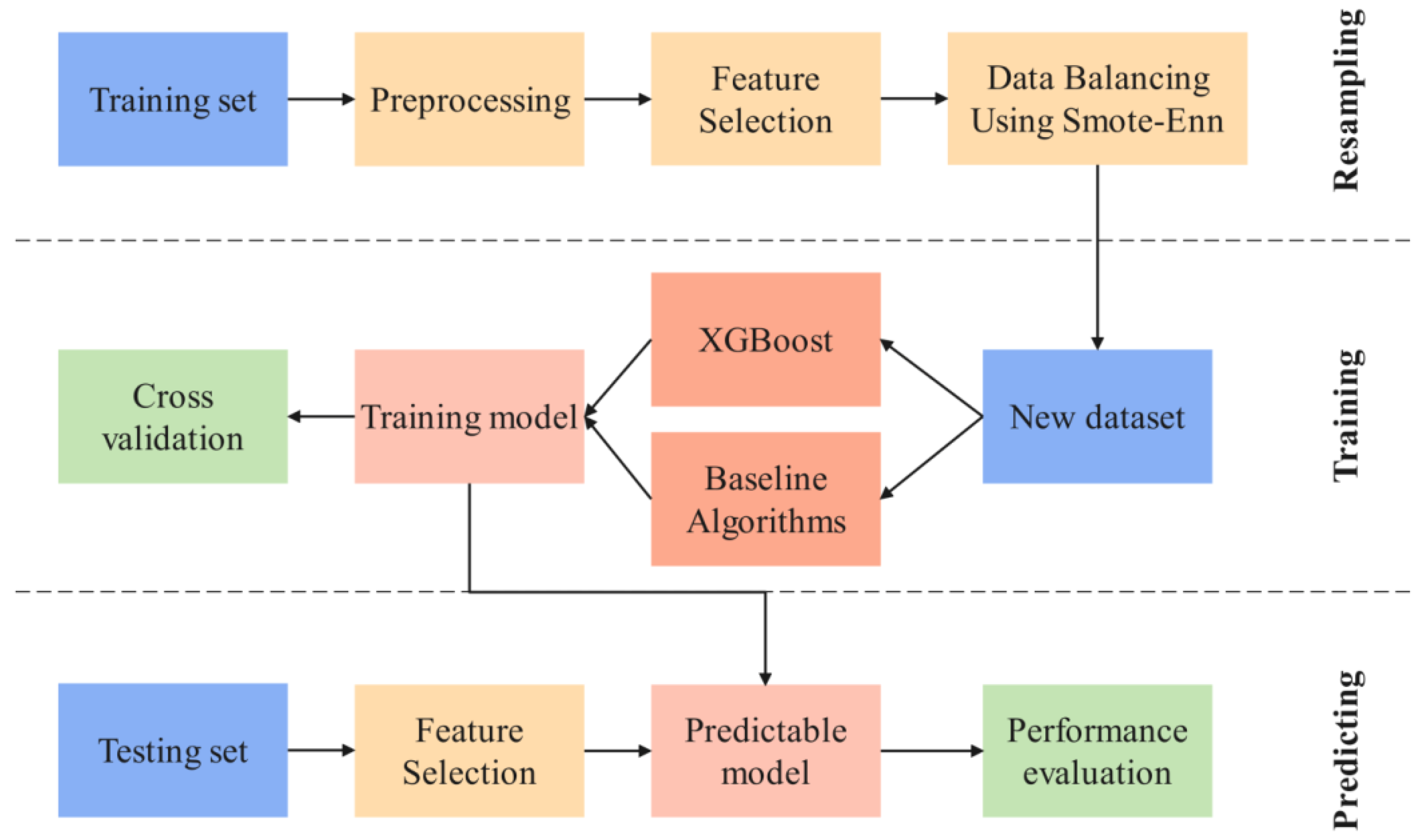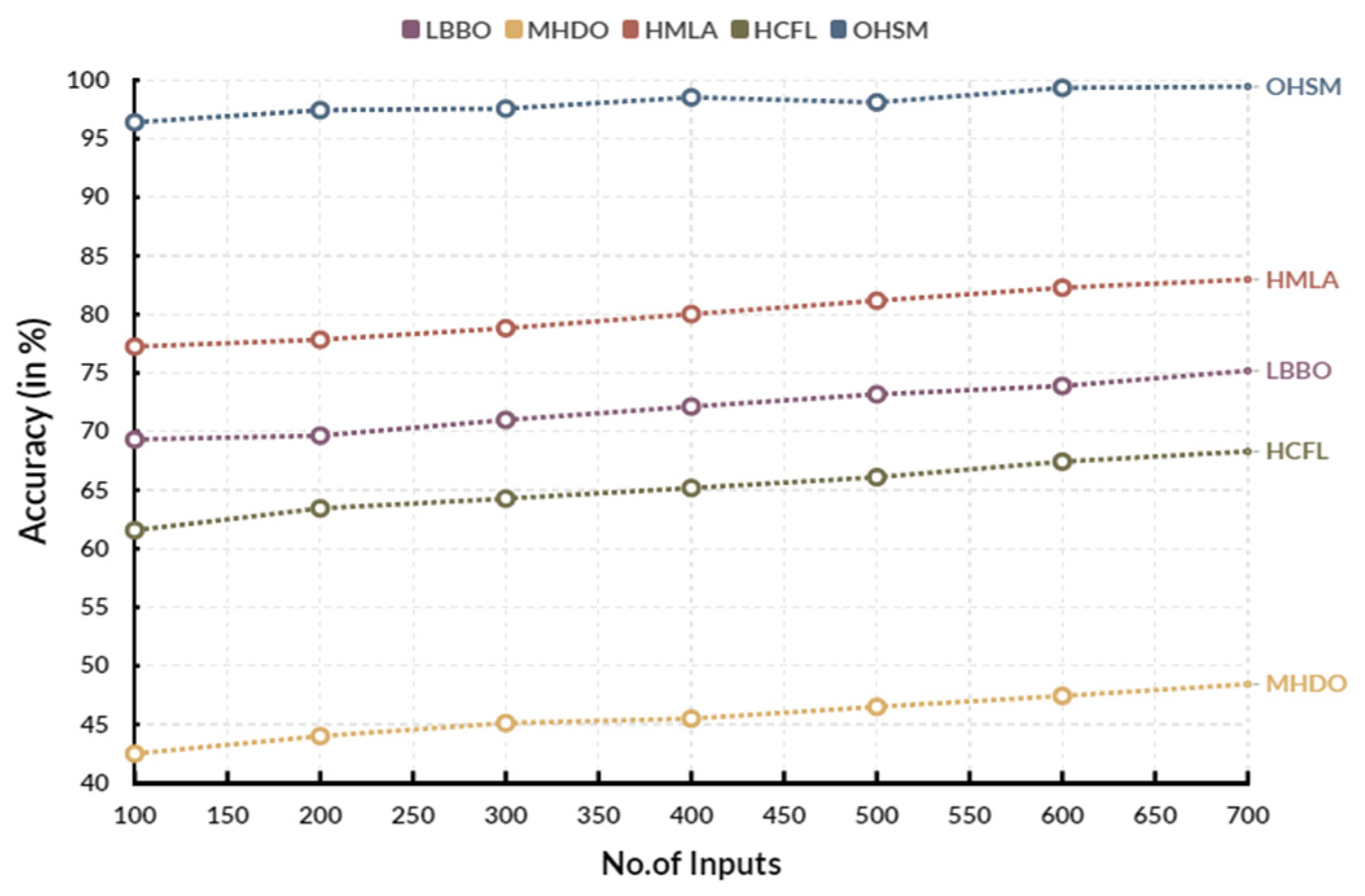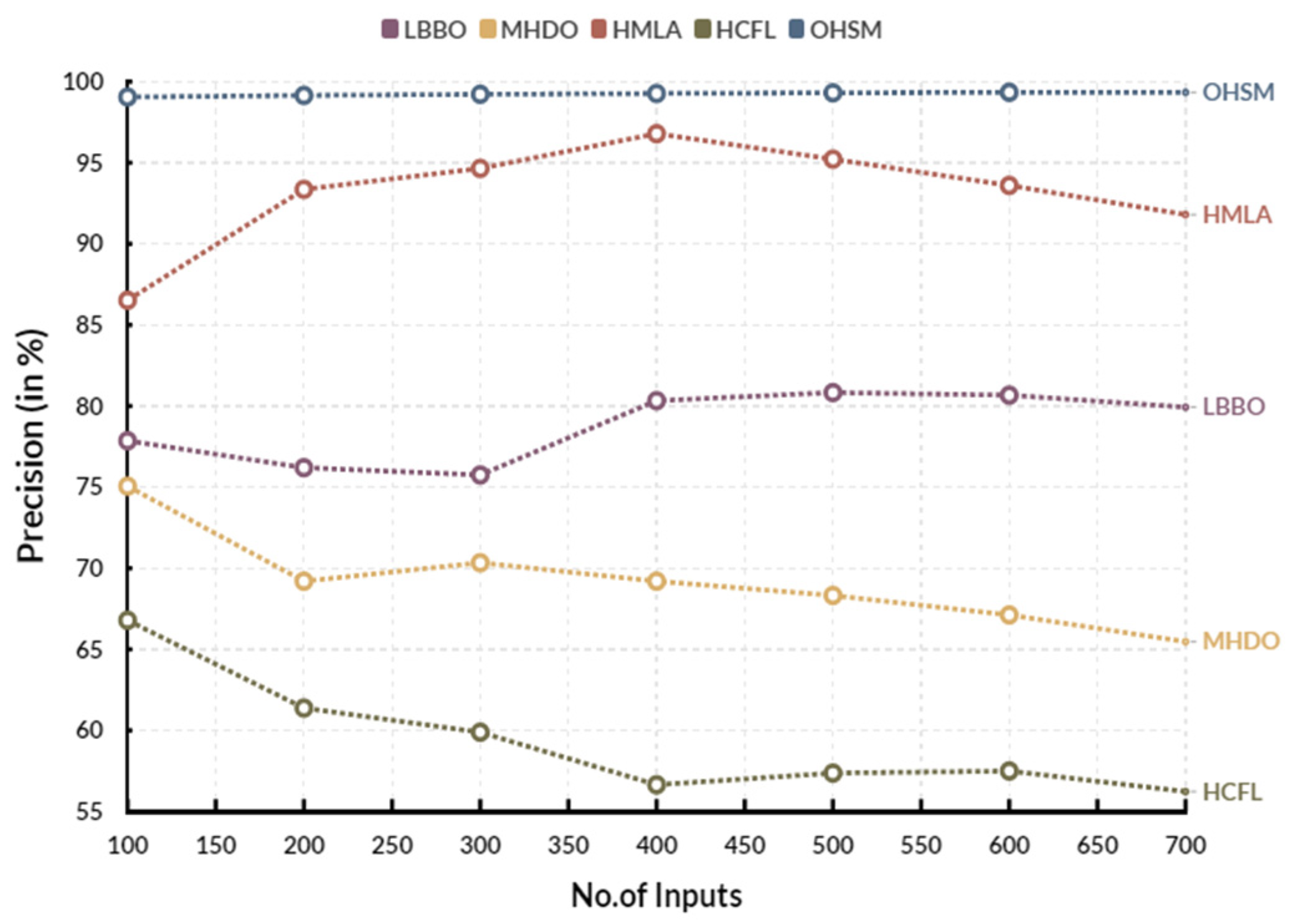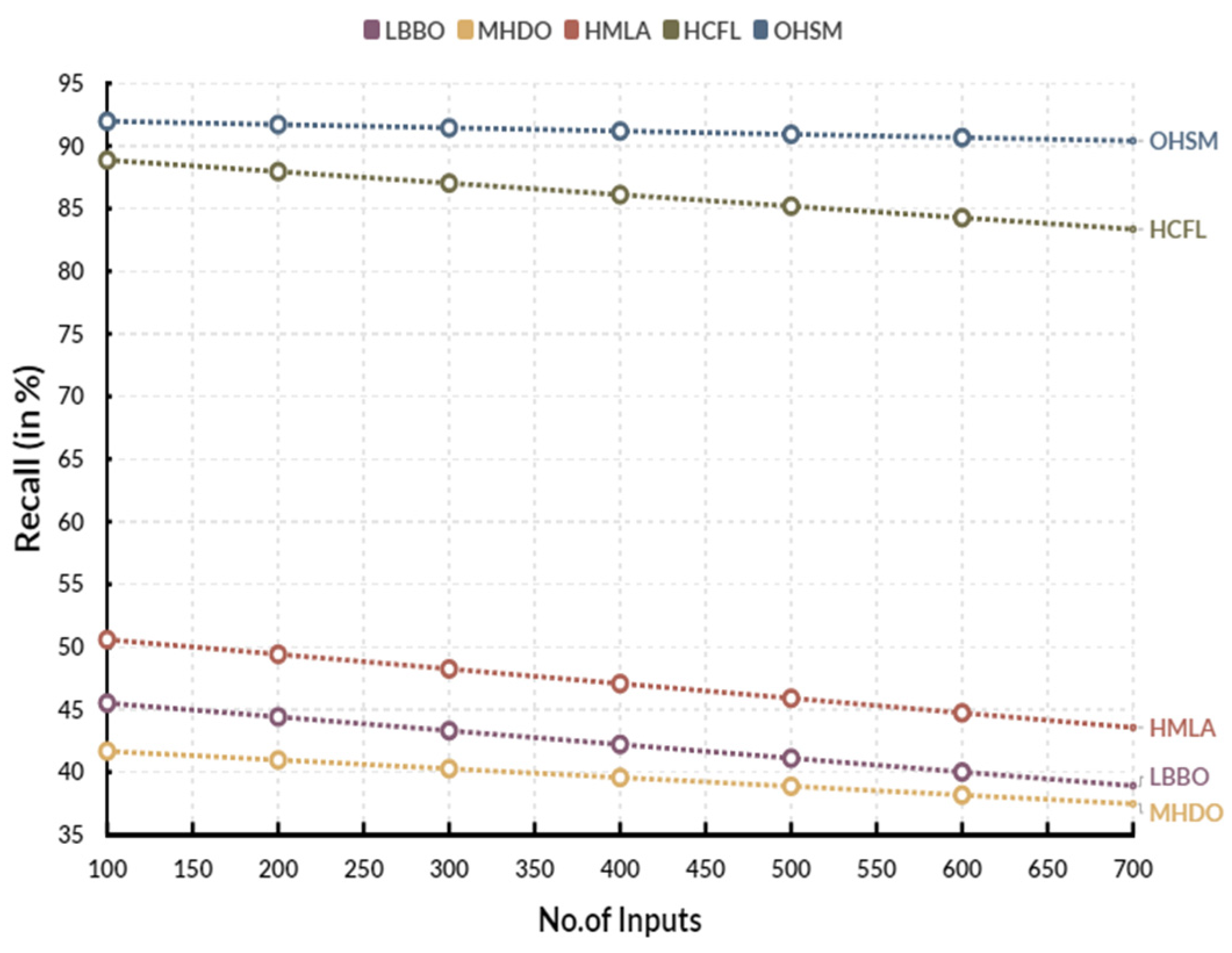A Novel Hyper-Spectral Model to Optimize the Prediction Rate for Heart Disease in Modern Healthcare Networks †
Abstract
:1. Introduction
- Enhancing Early Diagnosis and Treatment: Heart disease prediction helps to identify risk factors and initiate preventive measures to reduce the risk of developing heart complications. Early diagnosis and treatment enable healthcare professionals to take proactive action to protect and care for patients’ heart health.
- Improving Quality of Care: Heart disease prediction improves the quality of healthcare provided as it allows doctors to track any changes in the patient’s health over time. This helps to identify and address any problems quickly before they become larger concerns.
2. Materials and Methods
2.1. Proposed Model
2.2. Operating Principle
2.3. Functional Working
3. Results and Discussion
3.1. Computation of Accuracy
3.2. Precision
3.3. Recall
- Processing Power: Hyper-spectral models involve a large amount of data, which typically requires a powerful and efficient processor to manage these data. A powerful processor is essential to reduce the data processing and time complexity. A multi-core processor can also be beneficial for high-end applications.
- Memory: Hyper-spectral models involve a large amount of data, which requires ample memory. The use of a portable hard drive or other external storage devices can be helpful in managing large volumes of data. Additionally, cutting-edge technologies such as distributed computing can help reduce time by utilizing more than one machine to process the data.
- Time Complexity: Hyper-spectral models require a lot of computing resources and take time to process. Adopting methods such as parallel computing can reduce the time complexity significantly, as it splits the task into consecutive tasks that can be processed simultaneously. Additionally, optimizing algorithms can help increase the processing speed.
4. Conclusions
Author Contributions
Funding
Institutional Review Board Statement
Informed Consent Statement
Data Availability Statement
Conflicts of Interest
References
- Alamelu, V.; Thilagamani, S. Lion based butterfly optimization with improved YOLO-v4 for heart disease prediction using IoMT. Inf. Technol. Control. 2022, 51, 692–703. [Google Scholar] [CrossRef]
- Balaha, H.M.; Shaban, A.O.; El-Gendy, E.M.; Saafan, M.M. A multi-variate heart disease optimization and recognition framework. Neural Comput. Appl. 2022, 34, 15907–15944. [Google Scholar] [CrossRef]
- Rinesh, S.; Maheswari, K.; Arthi, B.; Sherubha, P.; Vijay, A.; Sridhar, S.; Waji, Y.A. Investigations on brain tumor classification using hybrid machine learning algorithms. J. Healthc. Eng. 2022, 2022, 2761847. [Google Scholar] [CrossRef]
- Yaqoob, M.M.; Nazir, M.; Khan, M.A.; Qureshi, S.; Al-Rasheed, A. Hybrid classifier-based federated learning in health service providers for cardiovascular disease prediction. Appl. Sci. 2023, 13, 1911. [Google Scholar] [CrossRef]
- Qureshi, M.; Warke, N. Application of Machine Learning for Heart Disease Prediction. In Proceedings of the 2nd International Conference on Artificial Intelligence: Advances and Applications (ICAIAA 2021), Singapore, 14 February 2022. [Google Scholar]
- Logeshwaran, J.; Adhikari, N.; Joshi, S.S.; Saxena, P.; Sharma, A. The deep DNA machine learning model to classify the tumor genome of patients with tumor sequencing. Int. J. Health Sci. 2022, 6, 9364–9375. [Google Scholar] [CrossRef]
- Sonawane, R.; Patil, H. Automated heart disease prediction model by hybrid heuristic-based feature optimization and enhanced clustering. Biomed. Signal Process. Control 2022, 72, 103260. [Google Scholar] [CrossRef]
- Wei, X.; Rao, C.; Xiao, X.; Chen, L.; Goh, M. Risk assessment of cardiovascular disease based on SOLSSA-CatBoost model. Expert Syst. Appl. 2023, 219, 119648. [Google Scholar] [CrossRef]
- Logeshwaran, J.; Malik, J.A.; Adhikari, N.; Joshi, S.S.; Bishnoi, P. IoT-TPMS: An innovation development of triangular patient monitoring system using medical internet of things. Int. J. Health Sci. 2022, 6, 9070–9084. [Google Scholar] [CrossRef]
- Zou, Z.; Wang, L.; Chen, J.; Long, T.; Wu, Q.; Zhou, M. Research on peanut variety classification based on hyperspectral image. Food Sci. Technol. 2022, 42, e18522. [Google Scholar] [CrossRef]
- Ay, Ş.; Ekinci, E.; Garip, Z. A comparative analysis of meta-heuristic optimization algorithms for feature selection on ML-based classification of heart-related diseases. J. Supercomput. 2023, 79, 11797–11826. [Google Scholar] [CrossRef] [PubMed]
- Dubey, A.K.; Sinhal, A.K.; Sharma, R. An Improved Auto Categorical PSO with ML for Heart Disease Prediction. Eng. Technol. Appl. Sci. Res. 2022, 12, 8567–8573. [Google Scholar] [CrossRef]
- Abdellatif, A.; Abdellatef, H.; Kanesan, J.; Chow, C.O.; Chuah, J.H.; Gheni, H.M. Improving the heart disease detection and patients’ survival using supervised infinite feature selection and improved weighted random forest. IEEE Access 2022, 10, 67363–67372. [Google Scholar] [CrossRef]
- Nirere, A.; Sun, J.; Kama, R.; Atindana, V.A.; Nikubwimana, F.D.; Dusabe, K.D.; Zhong, Y. Nondestructive detection of adulterated wolfberry (LyciumChinense) fruits based on hyperspectral imaging technology. J. Food Process Eng. 2023, 46, e14293. [Google Scholar] [CrossRef]
- Kiliçarslan, S. PSO+ GWO: A hybrid particle swarm optimization and Grey Wolf optimization based Algorithm for fine-tuning hyper-parameters of convolutional neural networks for Cardiovascular Disease Detection. J. Ambient Intell. Humaniz. Computing. 2023, 14, 87–97. [Google Scholar] [CrossRef]
- Hao, Z.; Ma, J.; Sun, W. The Technology-Oriented Pathway for Auxiliary Diagnosis in the Digital Health Age: A Self-Adaptive Disease Prediction Model. Int. J. Environ. Res. Public Health 2022, 19, 12509. [Google Scholar] [CrossRef]
- Pandey, S.; Kaur, R.; Sharma, B. Deep Learning and Data Mining Techniques for Cardiovascular Disease Prediction: A Survey. In Proceedings of the 2023 6th International Conference on Information Systems and Computer Networks (ISCON), Mathura, India, 3–4 March 2023. [Google Scholar]
- Nirere, A.; Sun, J.; Yuhao, Z. A Rapid Non-destructive Detection Method for Wolfberry Moisture Grade Using Hyperspectral Imaging Technology. J. Nondestruct. Eval. 2023, 42, 45. [Google Scholar] [CrossRef]
- Hong, S.J.; Park, S.; Lee, A.; Kim, S.Y.; Kim, E.; Lee, C.H.; Kim, G. Nondestructive prediction of pepper seed viability using single and fusion information of hyperspectral and X-ray images. Sens. Actuators A Phys. 2023, 350, 114151. [Google Scholar] [CrossRef]
- Venkatasubramanian, S.; Dwivedi, J.N.; Raja, S.; Rajeswari, N.; Logeshwaran, J.; Praveen Kumar, A. Prediction of Alzheimer’s Disease Using DHO-Based Pretrained CNN Model. Math. Probl. Eng. 2023, 2023, 1110500. [Google Scholar] [CrossRef]





Disclaimer/Publisher’s Note: The statements, opinions and data contained in all publications are solely those of the individual author(s) and contributor(s) and not of MDPI and/or the editor(s). MDPI and/or the editor(s) disclaim responsibility for any injury to people or property resulting from any ideas, methods, instructions or products referred to in the content. |
© 2023 by the authors. Licensee MDPI, Basel, Switzerland. This article is an open access article distributed under the terms and conditions of the Creative Commons Attribution (CC BY) license (https://creativecommons.org/licenses/by/4.0/).
Share and Cite
Abinaya, K.; Palaniappan, D.; Vedaraj, M. A Novel Hyper-Spectral Model to Optimize the Prediction Rate for Heart Disease in Modern Healthcare Networks. Eng. Proc. 2023, 59, 59081. https://doi.org/10.3390/engproc2023059081
Abinaya K, Palaniappan D, Vedaraj M. A Novel Hyper-Spectral Model to Optimize the Prediction Rate for Heart Disease in Modern Healthcare Networks. Engineering Proceedings. 2023; 59(1):59081. https://doi.org/10.3390/engproc2023059081
Chicago/Turabian StyleAbinaya, K., Damodharan Palaniappan, and M. Vedaraj. 2023. "A Novel Hyper-Spectral Model to Optimize the Prediction Rate for Heart Disease in Modern Healthcare Networks" Engineering Proceedings 59, no. 1: 59081. https://doi.org/10.3390/engproc2023059081





